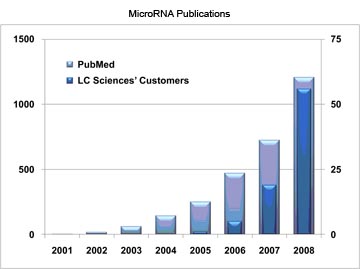LC Sciences announced today the publication of the 100th peer-reviewed study by one of its customers using the company’s microarray service for analyzing microRNA (miRNA) expression profiles and for discovery of novel small RNAs. These studies, by leading researchers in the field, contribute to a fast growing body of knowledge defining this recently discovered class of regulatory RNAs.
To date, miRNAs have proven to be extremely important part of the gene expression regulation mechanism. Expression profiling and functional studies conducted so far indicate that miRNAs participate in the regulation of almost every cellular process investigated and this is evident in the amount of relevant findings being translating into published reports.
The publications to date by LC Sciences’ customers span a diverse range of study areas, including cancer research, neuroscience, cardiovascular research, MicroRNA Publications reproductive biology, plant science, virology, stem cell research, immunology, and small RNA discovery. Their miRNA profiling service has provided a tool for many researchers to explore and examine a wide assortment of miRNA cellular networks and the resulting publications are often the first description of miRNA activity in these systems.
LC Sciences’ miRNA profiling service, powered by its µParaflo® microfluidic technology, provides quick, reliable, fully analyzed data enabling researchers to immediately move forward with innovative research, and publish their results faster. Microarray results require extensive validation prior to publication. The speed with which researchers using this miRNA profiling service have published their discoveries demonstrates the high-quality and reliability of these results.
The 100th study, entitled “MicroRNA-146a feedback inhibits RIG-I-dependent Type I IFN production in macrophages by targeting TRAF6, IRAK1, and IRAK2†appeared in the September issue of The Journal of Immunology and was one of a group of articles published recently by LC Sciences’ customers describing miRNA involvement in the immune system. Researchers at the National Key Laboratory of Medical Immunology, China studied the fine tuning effect that miRNA has on inflammatory response to viral infection and even propose a new mechanism for the evasion of innate immune control by viruses. MiRNA microarray data revealed, and real-time quantitative PCR confirmed, many up-regulated miRNAs in vesicular stomatitis virus (VSV) infected mouse macrophages. Specifically miR-146a expression was significantly up-regulated. Further studies revealed that miR-146a negatively regulated VSV-triggered interferon production (which is necessary to exert feedback control over inflammation) promoting VSV replication in macrophages. The identification of miRNAs and a better understanding of their expression in response to various stimuli/pathogens may reveal that miRNAs offer multiple new therapeutic targets/strategies for fine tuning the immune response to treat and prevent of a number of inflammatory diseases.
“We are very excited about the announcement of the 100th peer-viewed publication by one of our customers,†says Chris Hebel, VP of Business Development at LC Sciences. “MiRNA has become a very hot area of research and many scientists would like to be the first to describe the mechanism of miRNA as it relates to their field of study. We are happy to provide a first look into this exciting new field for them and are proud that our technology has been a part of such groundbreaking workâ€.
About µParaflo® Technology – The µParaflo® technology is a microfluidic platform for in situ parallel synthesis of biomolecular chips and miniaturization of bioassays including binding and enzymatic reactions. This unique platform technology is based on a new class of three-dimensional pico-liter microfluidic reaction devices, and a digital light controlled synthesis method that employs conventional oligonucleotide or peptide synthesis chemistry; a completely programmable process. The seamless integration of these multidisciplinary technologies enables a significant advance in parallelization, miniaturization, customization, and automation.
Via EPR Network
More Biotech press releases

